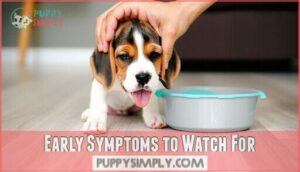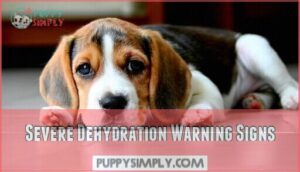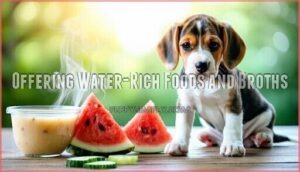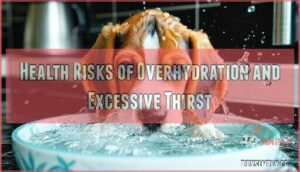This site is supported by our readers. We may earn a commission, at no cost to you, if you purchase through links.

Active puppies naturally require more water to regulate their body temperature and support their growing muscles. You’ll want to provide constant access to clean, cool water in a sanitized bowl. Watch for signs like lethargy or sticky gums, which indicate dehydration.
Several factors influence your puppy’s thirst patterns and hydration needs throughout the day.
Table Of Contents
- Key Takeaways
- How Much Water Should a Beagle Puppy Drink?
- Why Hydration is Critical for Beagle Puppies
- Signs Your Beagle Puppy is Dehydrated
- Encouraging Healthy Water Intake in Puppies
- Managing Water Intake During Potty Training
- Health Risks of Overhydration and Excessive Thirst
- Frequently Asked Questions (FAQs)
- How often should I refill my puppy’s water bowl during the day?
- What temperature should the water be for my puppy?
- Is it okay if my puppy likes drinking from puddles outside?
- Can beagle puppies drink tap water safely?
- What temperature water is best for puppies?
- Should I restrict nighttime water for housetraining?
- How often should I clean puppy water bowls?
- Can I add ice cubes to puppy water?
- Conclusion
Key Takeaways
- Calculate your beagle puppy’s daily water needs using 1.5 ounces per pound of body weight—a 10-pound puppy should drink roughly 15 ounces daily.
- You’ll need to increase water intake by up to 50% during hot weather or after vigorous play sessions since active puppies require more hydration.
- Watch for dehydration signs like lethargy, sticky gums, and poor skin elasticity—contact your vet immediately if your puppy won’t drink for over 12 hours.
- Don’t restrict water access during potty training since proper hydration is critical for your puppy’s health and development throughout their first year.
How Much Water Should a Beagle Puppy Drink?
Your beagle puppy needs about 1.5 ounces of water per pound of body weight daily, which means a 10-pound puppy should drink roughly 15 ounces of water each day.
This amount can vary based on your puppy’s activity level, the weather, and their overall health status.
Daily Water Intake Calculation
Your puppy’s water needs follow a simple formula that acts like a compass for proper hydration. Calculate daily water intake using your beagle puppy’s weight and these guidelines:
- 5-pound puppy: 2.5-5 ounces daily (about ⅓ cup)
- 10-pound puppy: 5-10 ounces daily (roughly ⅔ cup)
- 15-pound puppy: 7.5-15 ounces daily (nearly 2 cups)
- 20-pound puppy: 10-20 ounces daily (up to 2.5 cups)
Factors Affecting Water Needs
Several factors influence your beagle puppy’s water requirements beyond basic calculations. Activity level substantially impacts needs—active puppies require up to 50% more water than sedentary ones. **Health conditions like fever or digestive issues can double normal intake.
**
Water temperature affects consumption patterns, while bowl hygiene influences drinking frequency. Environmental factors and puppy size also determine individual hydration needs.
Adjusting for Age and Size
As your beagle puppy grows, their water requirements shift dramatically based on size and developmental stage. Puppies need up to 1.5 ounces per pound daily, while adult beagle hydration drops to 1 ounce per pound for size-based hydration.
- Your tiny 8-week-old puppy’s water needs will double by adulthood
- Senior beagle care requires extra attention as aging affects water conservation
- Breed-specific needs mean beagles drink more than many comparable breeds
- Puppy hydration monitoring becomes easier as they establish drinking patterns
- Body weight changes require constant water intake adjustments throughout their life
Why Hydration is Critical for Beagle Puppies
Water plays a vital role in your beagle puppy’s rapid growth and organ development during their first year of life. Without adequate hydration, puppies face serious health risks including urinary tract infections, kidney problems, and impaired immune function that can affect their long-term wellbeing.
Proper hydration fuels your beagle puppy’s critical first-year development and prevents serious health complications
Beagle Puppy Health and Development
During rapid growth phases, your beagle puppy’s developing body systems depend heavily on proper hydration to function perfectly. Water facilitates cellular processes, nutrient transport, and waste elimination that fuel healthy development through early socialization periods, teething challenges, and behavioral milestones.
| Development Stage | Hydration Impact |
|---|---|
| Puppy vaccinations | Aids immune response and recovery |
| Growth spurts | Promotes proper cellular division and tissue formation |
| Teething challenges | Maintains healthy gums and reduces discomfort |
| Early socialization | Facilitates energy levels for learning and play |
| Behavioral milestones | Guarantees ideal brain function and focus |
Risks of Inadequate Water Intake
When your beagle puppy doesn’t get enough water, serious health problems can develop quickly. Insufficient water intake puts your growing pup at risk for multiple complications that can affect their development and wellbeing.
Here’s what inadequate hydration can cause:
- UTIs and kidney issues – Poor water intake concentrates waste products, straining developing organs
- Puppy dehydration and electrolyte imbalance – Critical minerals become disrupted, affecting normal body functions
- Organ damage – Prolonged dehydration can permanently harm your puppy’s kidneys and other essential systems
Monitoring their water intake can help prevent underlying health issues.
Signs Your Beagle Puppy is Dehydrated
Recognizing dehydration early can prevent serious health complications in your beagle puppy. **You’ll need to watch for both subtle early warning signs and more obvious symptoms that require immediate veterinary attention.
Early Symptoms to Watch For
Dehydration can sneak up quietly, but you’ll notice subtle changes in your puppy’s behavior first. Watch for lethargy signs like reduced playfulness or excessive sleeping.
Check gum moisture by gently pressing their gums – they should feel wet, not sticky. Test skin elasticity by pinching loose skin; it should snap back quickly. Monitor capillary refill by pressing their gums until white, then releasing – color should return within two seconds.
Early detection prevents serious complications.
Severe Dehydration Warning Signs
When moderate dehydration progresses, your puppy faces dangerous territory. Severe signs of dehydration include dramatic loss of skin elasticity, sunken eyes that appear hollow, and an increased heart rate that signals distress.
Your puppy may show weakness, lethargy, or even collapse without immediate veterinary evaluation to address this life-threatening canine dehydration emergency.
When to Contact a Veterinarian
Your puppy’s life may depend on recognizing when professional help is needed. Contact your veterinarian immediately if you notice these warning signs:
- Refusal to drink water for more than 12 hours despite encouragement
- Persistent vomiting or bloody diarrhea that prevents fluid retention
- Severe lethargy where your puppy won’t respond to normal stimuli
- Sudden collapse or inability to stand, indicating critical dehydration
Don’t wait for multiple symptoms to appear—puppies dehydrate faster than adult dogs, and health issues can escalate quickly without proper veterinary advice and examination.
A sudden increase in whining can also indicate distress, so it’s important to pay attention to behavioral changes.
Encouraging Healthy Water Intake in Puppies
Getting your beagle puppy to drink enough water doesn’t have to be a challenge with the right strategies. You can encourage healthy hydration habits through proper bowl placement, smart feeding tools, and appealing water alternatives.
Water Bowl Placement and Cleanliness
When strategically placed near food or bedding areas, your puppy’s water bowl becomes easily accessible throughout the day. Clean bowls daily to prevent biofilm buildup that discourages drinking.
| Factor | Best Practice |
|---|---|
| Bowl Material | Stainless steel or ceramic prevents bacteria growth |
| Location Variety | Place multiple bowls near food, bedding, and play areas |
| Cleaning Frequency | Wash dog water bowl daily with soap and hot water |
| Biofilm Buildup | Scrub thoroughly to remove slippery film that forms naturally |
Finding the right puppy drinking solutions can greatly assist in ensuring your puppy stays hydrated. Fresh water availability encourages healthy hydration habits in puppies.
Using Slow-Feed and Portion-Control Bowls
Slow-feed bowls help prevent your puppy from gulping water too quickly, which can cause stomach upset or choking. These specialized designs encourage measured drinking while maintaining proper hydration habits. To find the perfect fit, explore a wide variety of options.
Consider these features when selecting the right water bowl:
- Bowl Material – Choose stainless steel or ceramic for easy cleaning
- Puppy Size – Match bowl depth to your beagle’s snout length
- Cleaning Frequency – Wash daily to prevent harmful biofilm buildup
Offering Water-Rich Foods and Broths
When offering water-rich fruits like watermelon or cucumbers, you’re supplementing water intake while providing essential nutrients for your puppy. Homemade broths with safe ingredients can encourage reluctant drinkers to consume more fluids. These wet food additions boost daily water content effectively, though they shouldn’t replace fresh water as your puppy’s primary hydration source.
Many owners also find success using water-rich puppy food. These wet food additions boost daily water content effectively, though they shouldn’t replace fresh water as your puppy’s primary hydration source.
Managing Water Intake During Potty Training
Managing water intake during potty training requires a careful balance between keeping your beagle puppy hydrated and establishing consistent bathroom schedules. You’ll need to monitor both water consumption and bathroom breaks to create predictable routines while ensuring your puppy gets adequate hydration throughout the day.
Balancing Hydration and Training Needs
While potty training requires careful scheduling, you can’t compromise your puppy’s health by restricting water intake. Smart Training Hydration Breaks help maintain Potty Training Balance without risking dehydration.
Consider these strategies:
- Consistent Water Access throughout the day with scheduled bathroom breaks
- Exercise Hydration Planning before and after activity sessions
- Rewarding with Water instead of treats during training sessions
Monitor your puppy’s activity level and adjust accordingly using a Dog Water Intake Calculator. Positive reinforcement, like rewarding successful breaks, can further encourage good habits.
Monitoring Intake and Bathroom Breaks
Track your puppy’s water intake against urination frequency to establish healthy patterns. Note drinking times and potty break timing to prevent accidents while ensuring adequate hydration.
Monitor for signs like decreased urination or dark urine, which may indicate dehydration and increase UTI risk. Regular veterinary checkups help confirm your puppy is drinking enough water for ideal health.
Health Risks of Overhydration and Excessive Thirst
While most beagle puppies need consistent water access, drinking too much can signal serious health problems or lead to dangerous water intoxication.
You’ll want to recognize when your puppy’s thirst becomes excessive and understand the risks that come with overhydration.
Causes of Excessive Drinking
Beyond normal puppy drinking habits, several medical conditions can trigger excessive water intake in your Beagle puppy. When your furry friend suddenly becomes a water-drinking machine, it’s time to investigate potential underlying causes.
- Hormonal disorders: Diabetes Insipidus and Cushing’s Disease disrupt normal thirst regulation, causing polydipsia in puppies.
- Organ dysfunction: Kidney disease and liver disease impair the body’s ability to concentrate urine properly.
- External factors: Medication side-effects or Psychogenic Polydipsia can lead to abnormal excessive water intake patterns.
Kidney problems remain the most common culprit behind persistent polydipsia in young dogs. A vet examination is vital to determine if your dog is experiencing increased thirst.
Recognizing Water Intoxication
Water intoxication threatens puppies when excessive water intake causes electrolyte imbalance. You’ll notice coordination loss, bloating, glazed eyes, and drooling as early warning signs. Brain swelling from dilution hyponatremia creates serious symptoms including vomiting, lethargy, and seizures.
Beagle puppies face higher risk due to their small size and enthusiastic puppy behavior around water sources. Veterinary intervention becomes critical immediately when overhydration symptoms appear, as untreated water intoxication proves fatal within hours.
Addressing Underlying Health Issues
If your Beagle puppy shows excessive thirst, underlying medical conditions could be the culprit. Kidney problems, diabetes insipidus, Cushing’s disease, and liver failure all trigger increased water consumption. Early detection protects your puppy’s health status and prevents complications like electrolyte imbalance or urinary tract infections.
- Kidney Problems – Watch for changes in urination frequency alongside increased drinking
- Diabetes – Monitor for sudden appetite changes, weight loss, or lethargy in puppies
- Cushing’s Disease – Look for excessive panting, pot-bellied appearance, or skin issues
Frequently Asked Questions (FAQs)
How often should I refill my puppy’s water bowl during the day?
You’ll want to refresh your puppy’s water bowl twice daily with fresh, clean water. Monitor the level throughout the day, topping off as needed since puppies drink frequently.
What temperature should the water be for my puppy?
Room temperature water works best for your puppy. Cool water can upset their sensitive stomach, while warm water may discourage drinking. Keep it fresh and clean daily.
Is it okay if my puppy likes drinking from puddles outside?
Puddles contain harmful bacteria, parasites, and chemicals that can make your puppy seriously ill. You shouldn’t let them drink from outdoor puddles – stick to fresh, clean water bowls instead for their safety.
Can beagle puppies drink tap water safely?
Yes, most beagle puppies can safely drink tap water in areas with treated municipal water supplies. However, you’ll want to check your local water quality and consider filtering if there’s high chlorine or contaminants.
What temperature water is best for puppies?
Room temperature water works best for puppies since it’s easiest on their digestive systems. You’ll want to avoid extremely cold or hot water, which can discourage drinking or cause stomach upset.
Should I restrict nighttime water for housetraining?
Most puppies can comfortably sleep through eight-hour stretches without water access. You can safely restrict nighttime water two hours before bedtime, but make certain your beagle puppy drinks adequately during daytime hours to meet their hydration needs.
How often should I clean puppy water bowls?
You should clean your puppy’s water bowl daily to prevent bacterial growth and biofilm buildup. Daily washing with soap guarantees fresh, appealing water that promotes proper hydration.
Can I add ice cubes to puppy water?
Ice cubes can make drinking more appealing for puppies, especially during hot weather. You can safely add them to your beagle puppy’s water bowl to encourage hydration and provide enrichment.
Conclusion
Consider Sarah’s 8-week-old beagle puppy, Max, who weighs 6 pounds and drinks about 9 ounces daily. After his first vet visit, Sarah learned this amount perfectly matches the recommended intake guidelines.
Determining how much water should a beagle puppy drink requires careful attention to your pet’s individual needs. Monitor your puppy’s daily consumption using the 1.5 ounces per pound formula while watching for dehydration signs.
Remember that hot weather and active play increase water requirements substantially. Maintaining proper hydration promotes healthy growth and development throughout your beagle’s puppyhood.
- http://www.cdc.gov/fluoridation/statistics/2012stats.htm
- http://www.merckvetmanual.com/pethealth/special_subjects/poisoning/fluoride_poisoning.html
- http://eepurl.com/86XZ1
- https://gooddogpeople.com/blogs/dog-talk/understanding-dog-polydipsia-excessive-thirst-and-its-causes
- https://bayshore-vet.com/veterinary-blog/why-is-my-dog-drinking-so-much-water/















